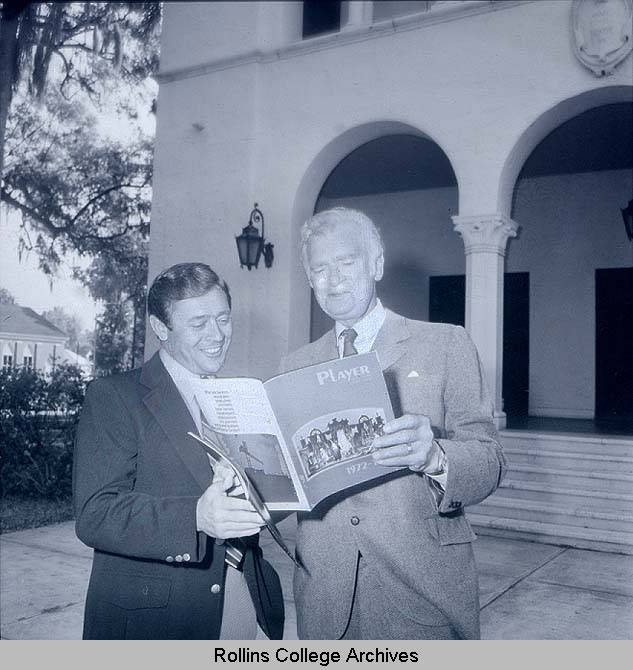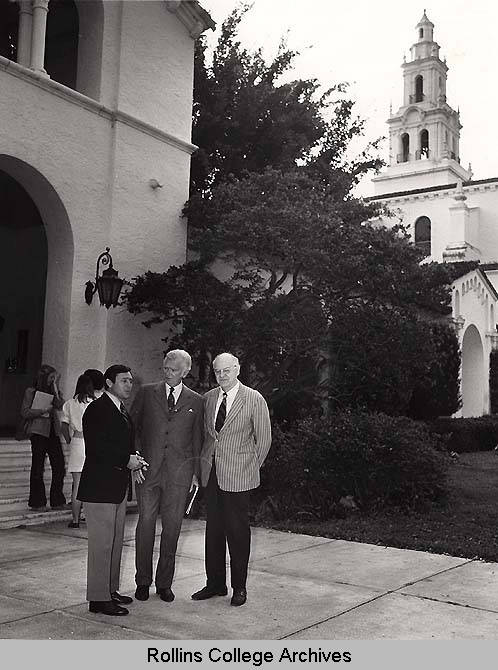|
Christian
Rudolph “Buddy” Ebsen, Jr., born to Christian Rudolph Sr. and Frances
Ebsen on April 2, 1908, lived in
Belleville
,
Illinois
until the age of ten. His father
taught physical education and dance, and his mother worked as a seamstress and
costumer. The family, including
Ebsen’s four sisters, then moved to
Palm Beach
,
Florida
(where a fastball to the throat resulted in Ebsen’s signature voice) until
1920, when they relocated to
Orlando. In high school, Ebsen took
ballet lessons, but later switched to playing football as a guard because of
his peer’s ridicule. During the
years of 1924 to 1926, Ebsen placed five times in swimming meets. His interest
in dance returned after viewing a vaudeville performance at the Bijou Theater.
Additionally, he worked at the pharmacy in the Angebilt Hotel as a
waiter, then as a soda jerk. Ebsen
attended
Orlando
High School
, graduating in
 1926.
Initially, he had an interest in medicine.
He attended the
University
of
Florida
in
Gainesville
from 1926 to 1927, then
Rollins
College
in
Winter Park
from 1927 to 1928. The collapse of
Florida
’ land boom, however, led to economic difficulty and prompted Ebsen to
discontinue higher education at age twenty. Meanwhile,
Ebsen’s father served as a dancing instructor on the faculty of Rollins from
1928 to 1932. 1926.
Initially, he had an interest in medicine.
He attended the
University
of
Florida
in
Gainesville
from 1926 to 1927, then
Rollins
College
in
Winter Park
from 1927 to 1928. The collapse of
Florida
’ land boom, however, led to economic difficulty and prompted Ebsen to
discontinue higher education at age twenty. Meanwhile,
Ebsen’s father served as a dancing instructor on the faculty of Rollins from
1928 to 1932.
Ebsen
moved to
New York
in 1928, with fifty dollars borrowed from his sister, Norma.
He sought to further his career as a dancer, but had only twenty-five
cents left when he met an old friend who found Ebsen employment in a
drugstore. Ebsen's break into
performance art began with his role as a chorus boy in Whoopee.
Ebsen then sent for his sister Vilma, and the two of them created a
dance partnership (called “The Baby Astaires”), appearing on the Broadway
production of Flying Colors. The duo then participated in a film,
Metro–Goldwyn–Mayer Incorporated’s (M.G.M.) Broadway Melody of 1936.
Ebsen’s sister left the entertainment industry, but he remained and
appeared in Captain January (1936), Broadway Melody of 1938, and
The Girl of the Golden West (1938).
Ebsen had a supporting role in Born to Dance (1936) and, owing
to his unique style of dance, Walt Disney had a dancing Ebsen filmed in front
of a grid to aid Mickey Mouse’s animators during the production of Silly
 Symphonies (1929 to 1939). Additionally,
M.G.M. cast Ebsen as the Scarecrow in The Wizard of Oz (1939), a part
he traded for that of the Tinman. An
allergic reaction to the aluminum dust utilized for cosmetic effect, however,
led to Ebsen’s hospitalization for severe respiratory difficulties; he could
not return to the film. Symphonies (1929 to 1939). Additionally,
M.G.M. cast Ebsen as the Scarecrow in The Wizard of Oz (1939), a part
he traded for that of the Tinman. An
allergic reaction to the aluminum dust utilized for cosmetic effect, however,
led to Ebsen’s hospitalization for severe respiratory difficulties; he could
not return to the film.
In
the aftermath of a contract dispute with M.G.M., Ebsen took up sailing and,
because of his proficiency, taught the skill to candidates for the United
States Navy. He attempted on
multiple occasions to enlist in the Navy in 1941, but the Navy denied his
applications. Thus, Ebsen instead
joined the Coast Guard as a Lieutenant, Junior Grade, and served as damage
control officer and later as an executive officer as a weather recorder on the USS Pocatello. In 1946, the Coast Guard honorably
discharged Lieutenant Ebsen, thus adding patriot to his list of
accomplishments.
Ebsen returned to acting
following his time in the Coast Guard. In
1947 and 1948, he played Tommy Turner in the Rollins production of The Male
Animal. Ebsen also took parts
in various television shows after debuting on a 1949 episode of The
Chevrolet Tele-Theatre. In the
1958 to 1959 season, Ebsen co-starred the National Broadcasting Company’s (N.B.C.)
early color program,
Northwest Passage
, as Sergeant Hunk Marriner. Ebsen
also participated in many films, such as Breakfast
at Tiffany's (1961). His most
well-known role, however, was that of Jed Clampet
in The Beverly Hillbillies (1962-1971)
and in the made-for-television movie Return of The Beverly
Hillbillies (1981). Also,
Ebsen had the title role in series Barnaby Jones (1973 to 1980).
In 1993, he did a cameo appearance as Barnaby Jones in film version of The
Beverly Hillbillies (1993).
In regards to his personal
life, in 1936, Ebsen married Ruth Cambridge, with whom he had two daughters:
Elizabeth and Alix. He and Ruth
divorced in 1942 and two years later, he married Nancy Wilcott. His
second marriage produced five children: Susannah, Cathy, Bonnie, Kiersten, and
Dustin, and also ended in divorce in 1985.
That year, he married Dorothy Knott, with whom he had a child.
Ebsen had many hobbies. He
enjoyed activities such as dancing, swimming, sailing, and painting.
During his later years, Ebsen sold his own folk art.
He died of pneumonia on July 6, 2003 in
Torrance,
California, but Ebsen remains one of the Rollins’ most recognizable alumni.
- Angelica Garcia
|


